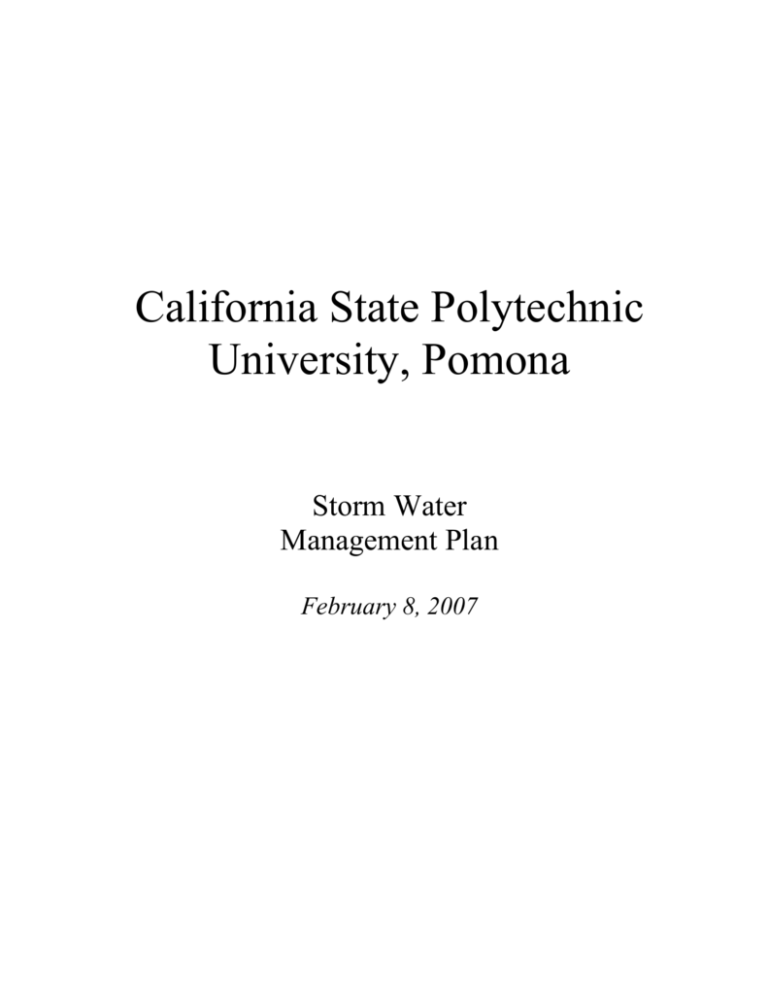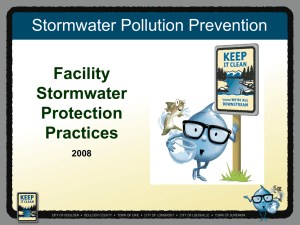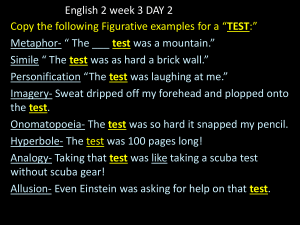Storm Water Management Plan
advertisement

California State Polytechnic University, Pomona Storm Water Management Plan February 8, 2007 TABLE OF CONTENTS 1.0 2.0 3.0 4.0 5.0 6.0 7.0 Introduction 1.01 Regulatory Background 1.02 Purpose of the SWMP 1.03 BMP Development Committee Site Information 2.01 Facility Description 2.02 Facility Operation Description of Potential Sources of Pollution 3.01 Potential Pollutant Sources MEP Standards and BMPs 4.01 What are Minimum Control Measures, MEP, and BMPs 4.02 How to use BMPs to Meet MEP Requirements 4.03 Minimum Control Measures 4.03.1 Public Education and Outreach on Storm Water Impacts MEP standards Measurable Goals to meet MEP Standards 4.03.2 Public involvement / Participation MEP standards Measurable Goals to meet MEP Standards 4.03.3 Illicit Discharge Detection and Elimination MEP standards Measurable Goals to meet MEP Standards 4.03.4 Pollution Prevention / Good Housekeeping for Facilities Operation and Maintenance MEP standards Measurable Goals to meet MEP Standards 4.03.5 Construction Site Storm Water Runoff Control MEP standards 4.03.5.1 Construction Projects Larger Than One Acre 4.03.5.2 Construction Projects Less Than One Acre Measurable Goals to meet MEP Standards 4.03.6 Post-construction Storm Water Management in New Development and Redevelopment MEP standards Measurable Goals to meet MEP Standards Record Keeping and Reporting 5.01 SWMP Updating 5.02 SWMP Public Access 5.03 SWMP Annual Reports Certifications and Signatures Appendices 7.01 Appendix 1 Main Campus Facility Information 7.02 Appendix 2 Off-Site Facility Information 7.03 Appendix 3 Construction Project Specifications (1 acre) California State Polytechnic University, Pomona Storm Water Management Plan Revision 2.0 – February 8, 2007 Page 3 4 5 6 6 7 8 9 10 12 13 15 16 17 18 20 23 2 1.0 Introduction 1.01 Regulatory Background This Storm Water Management Plan (SWMP) is required under Federal Environmental Protection Agency Phase II Storm Water regulations, promulgated under the Clean Water Act. These regulations require California State Polytechnic University, Pomona to apply for a National Pollution Discharge Elimination System (NPDES) permit by, and develop a SWMP. Polluted Storm Water runoff is often transported to municipal separate storm sewer systems (MS4s) and ultimately discharged into local waterways (rivers, streams, lakes, and bays) without treatment. EPA’s Storm Water Phase II Rule establishes an MS4 Storm Water management program that is intended to improve the nation’s waterways by reducing the quantity of pollutants that Storm Water picks up and carries into storm sewer systems during storm events. Common pollutants include oil and grease from roadways and parking lots, pesticides from lawns, sediment from construction sites, and carelessly discarded trash, such as cigarette butts, paper wrappers and plastic bottles. These pollutants are deposited into nearby waterways, discouraging recreational use of the resource, and interfering with the habitat for fish, other aquatic organisms, and wildlife. In 190, EPA promulgated rules establishing Phase I of the NPDES Storm Water program. The Phase I program for MS4s requires operators of “medium” and “large” MS4s, that is, those that generally serve populations of 100,000 or greater, to implement a Storm Water management program as a means to control polluted discharges from these MS4s. The Storm Water Phase II Rule extends coverage of the NPDES Storm Water program to certain “small” MS4s, but takes a slightly different approach to how the Storm Water management program is developed and implemented. NPDES Phase II regulations require operators of small MS4s to develop a program in order to: Reduce the discharge of pollutants to the “maximum extent practicable” (MEP); Protect water quality; and Satisfy the appropriate water quality requirements of the Clean Water Act and Regional Water Quality Control Board Basin Plan California State Polytechnic University, Pomona Storm Water Management Plan Revision 2.0 – February 8, 2007 3 1.02 Purpose of the SWMP This document has been developed to comply with Environmental Protection Agency Phase II National Pollutant Discharge Elimination System requirements promulgated under the Clean Water Act. The purpose of the SWMP is: (1) to identify pollutant sources potentially affecting the quality and quantity of Storm Water discharges; (2) to provide Best Management Practices (BMPs) for municipal and small construction activities implemented by California State Polytechnic University, Pomona staff and contractors and; (3) provide measurable goals for the implementation of this SWMP to reduce the discharge of the identified pollutants into the storm drain system and associated water ways. This SWMP covers California State Polytechnic University, Pomona’s main campus and its offsite facilities situated in urban areas. 1.03 SWMP Development Committee The SWMP was developed with input from representatives from various campus departments with a potential to impact surface water quality. Included were a variety of off-site facilities. The campus committee members ranged from departmental directors to operations personnel. California State Polytechnic University, Pomona Plan Off-site Facilities of the University Participants Planning, Design & Construction – Capital Projects, Project Management, Inspection Services Pinetree Ranch Environment, Health & Safety Chino Agriculture Acreage College of Agriculture Parking & Transportation Facilities Management – Utilities, Refuse and Recycling, Trades, Gardeners, Custodial Services, Pest Management Associated Students Inc. Cal Poly Pomona Foundation California State Polytechnic University, Pomona Storm Water Management Plan Revision 2.0 – February 8, 2007 Spradra Ranch 4 2.0 Site Information 2.01 Facility Description California State Polytechnic University, Pomona (CSPU), is one of twenty three CSU campuses governed by the Chancellor of the California State University System and is an internationally recognized public teaching and research institution. The California State Polytechnic University, Pomona Main Campus is situated in Los Angeles County and northwest of the city of Pomona. The facility is generally bounded by interstate 10 freeway to the north, the Pomona and Valley Boulevards to the east, Temple Avenue to the south, and Bonita Avenue to the west. This SWMP covers all facilities in urbanized areas owned and operated by California State Polytechnic University, Pomona (such as the Main Campus, Spadra Ranch, Pinetree Ranch and the Chino Agriculture Acreage). Off-site facility operations vary widely and not all BMPs in the SWMP may apply at each off-site location. Specific facility information is attached in Appendix 1. The current 2006-2007 population, which includes students, faculty, staff, visiting scholars, researchers and visitors, is approximately 31,000. An estimated growth rate of less than 7% over the next ten years does not trigger the Standard Urban Storm Water Mitigation Plan (SUSMP) requirements for new construction projects. 2.02 Facility Operation California State Polytechnic University, Pomona employs maintenance, custodial, and grounds staff for day to day operations. This includes building maintenance (cleaning, painting, repairs), completion of department work requests, daily cleaning of common buildings, grounds maintenance, small construction jobs, and various repair and maintenance activities. Campus Facilities Management staff and outside contractors do electrical, plumbing, roofing, asphalt, exterior building painting, parking lot cleaning, sewer line cleaning, utility repairs, and janitorial duties. California State Polytechnic University, Pomona Storm Water Management Plan Revision 2.0 – February 8, 2007 5 3.0 Description of Potential Sources of Pollution 3.01 Potential Pollutant Activity or Sources List In order to aid in the identification of pollutant sources, the working group that developed this SWMP utilized information on historic spills as well as knowledge on the day to day operations to identify activities and sources of potential pollutants of concern. Best Management Practices (BMP) to address the pollutant sources and activities described below will be developed as described in the Minimum Control Measures (Section 4.03). Activity / Source Building maintenance (washing, graffiti abatement) Chemical spills Construction activities Erosion Food service operations Grounds maintenance Impervious areas Litter and debris Loading / unloading areas Outdoor storage of raw materials Painting (indoor) Painting (outdoor) Parking lot runoff Roof runoff Sewer line blockages Sewer line seepage Trash storage areas Vehicle and equipment washing (staff) Utility line maintenance and repairs (water / irrigation! sewer) Animal feces / urine Swimming Pool Fleet Maintenance & Repair Pollutants of Concern Wash water, paint chips, cleaning products, dirt and sediment. Various- cleaning compounds, diesel, paint, hazardous materials, vehicle fluids Concrete, drywall, paint, sediment Sediment, organic matter Wash-water, food residue, oil and grease Green waste, fuel, oil, pesticides, herbicides, sediment Increased flows and pollutant loading Litter and debris Petroleum products, fertilizers, pesticides, herbicides, cleaning solutions, paint Sand, asphalt, soil pesticides, herbicides, fertilizer, paint, solvents, fuel Paint or rinse water (oil and water based), paint thinner Paint or rinse water (oil and water based), paint thinner Oil / grease, litter, heavy metals Particulate matter and associated pollutants Raw sewage Raw sewage Organic materials, hazardous materials Cleaning products, oil / grease, vehicle fluids Chloramines, chlorine, sediment, adhesive cements, primers & fire protection systems Coliform bacteria Chlorine Oils, gasoline and diesel 4.0 MEP Standards and BMPs 4.01 What are Minimum Control Measures, MEP, and BMPs “Minimum Control Measures” is the term used by the EPA for the six MS4 program elements aimed as achieving improved water quality through NPDES Phase II requirements listed below: Public Education and Outreach on Storm Water Impacts Public Involvement / Participation Illicit Discharge Detection and Elimination Pollution Prevention / Good Housekeeping for Facilities Operation, Maintenance and inspections. Construction Site Storm Water Runoff Control Post-construction Storm Water Management in New Development and Redevelopment California State Polytechnic University, Pomona Storm Water Management Plan Revision 2.0 – February 8, 2007 6 The goal of the SWMP is to reduce the discharge of pollutants to the Maximum Extent Practicable (MEP), as defined by the EPA, and to identify activities or structural improvements that help reduce the quantity and improve the quality of the Storm Water runoff. Best Management Practices (BMPs) have been developed for the SWMP to reduce the discharge of pollutants to the storm drain system to the MEP, BMPs include treatment controls, operating procedures, and practices to control site runoff, spills and leaks, sludge or waste disposal, or drainage from raw material storage. BMPs will be updated as appropriate to comply with any additions or changes to NPDES permit requirements. 4.02 How to use BMPs to Meet MEP Requirements The MBPs described in this document in the measurable goals section are to be implemented by California State Polytechnic University, Pomona staff and outside contractors. Whenever CSPU staff or contractors perform work on the campus or associated areas, steps outlined in each relevant BMP, or other proven technique that reaches the same goal, must be used in order to ensure compliance with Storm Water discharge regulations. California State Polytechnic University, Pomona has already initiated many of the BMPs listed in the Minimum Control Measures in this SWMP. In some cases the measure has not been formalized into a written plan or program. The SWMP will formalize and document these Minimum Control measures and associated BMPs. Full development and implementation of BMPs will be completed through the five-year implementation plan as presented in the measurable goals for each Minimum Control Measure in the following sections. California State Polytechnic University, Pomona Storm Water Management Plan Revision 2.0 – February 8, 2007 7 4.03 Minimum Control Measures 4.03.1 Public Education and Outreach on Storm Water Impacts The goal of this minimum control measure is to develop and distribute educational materials and perform outreach to inform students, faculty, and staff about the impact of polluted Storm Water runoff discharges, and that their actions can make a positive impact on water quality. Maximum Extent Practicable (MEP) Standards Implement a public education program to distribute educational materials to the community, or conduct equivalent outreach activities about the impacts of Storm Water discharges on local water bodies and the steps that can be taken to reduce Storm Water pollution; Determine the appropriate best management practices (BMPs) and measurable goals for this minimum control measure. Some program implementation approaches BMPs (i.e., the program actions / activities). Measurable Goals to Meet MEP Requirements Year Public Education and Outreach on Storm Water Impacts Goals 1 Develop Storm Water pollution prevention educational material for faculty and staff. Purchase permanent (10 year) storm drain markers (stencils). Begin stenciling campus storm drains. Develop Storm Water pollution prevention information for EH&S website. 2 Continue stenciling campus storm drains as needed. Distribute educational material to faculty and staff. Post Storm Water pollution prevention information on EH&S website. Increase Storm Water pollution prevention outreach to surrounding community. Develop educational material for students. 3 Continue stenciling campus storm drains as needed. Distribute educational material to students. Sponsor and / or participate in Storm Water pollution prevention events such as campus clean-ups. 4 Continue stenciling campus storm drains as needed. Continue sponsoring and / or participating in Storm Water pollution prevention events such as campus clean-ups. Outreach to faculty / academic programs for possible guest lectures. 5 Continue stenciling campus storm drains as needed. Continue sponsoring and / or participating in Storm Water pollution prevention events such as campus clean-ups. Write articles on Storm Water program for campus publications and newsletters. Include educational information in new student orientation packets. Give guest lecture on Storm Water runoff impacts / pollution prevention. California State Polytechnic University, Pomona Storm Water Management Plan Revision 2.0 – February 8, 2007 8 4.03.2 Public Involvement / Participation The goal of this minimum control measure is to provide opportunities for students, faculty, and staff to participate in program development and implementation on a Storm Water management working-group. MEP Standards Interact, comply and insure consistency with applicable State, and local public program requirements; Determine the appropriate best management practices (BMPs) and measurable goals for this minimum control measure. Measurable Goals to Meet MEP Requirements Year Public Involvement / Participation Goals 1 Establish on-going Storm Water working group and conduit for public comment. Make copies of the SWMP available at EH&S office, website and campus libraries. Place email link on EH&S website to report Storm Water pollution. 2 Contact campus community environmental event organizers. Convene campus Storm Water working group. Use media and publications promoting program and participation. 3 Participate in campus Storm Water pollution prevention event(s). Continue to convene campus Storm Water working group. 4 Organize and sponsor campus volunteer clean-up event. Continue to convene campus Storm Water working group. 5 Organize and sponsor another campus volunteer clean-up event. Participate in campus Storm Water pollution prevention event(s). Continue to convene campus Storm Water working group. California State Polytechnic University, Pomona Storm Water Management Plan Revision 2.0 – February 8, 2007 9 4.03.3 Illicit Discharge Detection and Elimination The goal of this minimum control measure is to develop and implement a plan to detect and eliminate non-Storm Water discharges (illicit discharges) such as process water, wash water, chemical spills, and other non-rainwater discharges to the storm drain system (not applicable to exempt discharges). MEP Standards Have a storm sewer system map, showing outfall locations and the names and location of all waters of the United States that receive discharges from those outfalls; Through management, contracting, or other mechanism, prohibit (to the extent allowable under State, or local law) non-Storm Water discharges into the MS4, and appropriate enforcement procedures and actions; Have a plan to detect and address non-Storm Water discharges, including illegal dumping, into the MS4; Educate “the public” about the hazards associated with illegal discharges and improper disposal of water, Determine the appropriate best management practices (BMPs) and measurable goals for this minimum control measure. Measurable Goals to Meet MEP Requirements Year Illicit Discharge Detection and Elimination Goals 1 Review and evaluate campus facilities storm drain maps Review and update campus notification system for sewage spills and other non-Storm Water discharges. Develop storm drain outfall monitoring program to visually identify dry weather flows into the storm drain system. Develop an interior drain assessment program to identify and re-route illicit connections. 2 Update campus storm drain maps as necessary. Implement updated campus notification system for sewage spills and other non-Storm Water discharges. Begin implementation of drain assessment program (building as-built review and interviews with campus plumbers). Implement storm drain outfall monitoring program. Inform staff of hazards associated with illicit discharges / disposal. 3 Develop a campus policy that includes prohibiting non-Storm Water discharges. Continue to update campus storm drain map. Continue to implement the drain assessment program (dye test, mark drains, and document findings) Continue to implement storm drain outfall monitoring program. Develop inspection program for illicit discharges / disposal. California State Polytechnic University, Pomona Storm Water Management Plan Revision 2.0 – February 8, 2007 10 4 5 Continue to update campus storm drain map. Continue to implement the drain assessment program (complete drain identification and marking and prioritize the re-routing of illicit connections). Implement inspection program for illicit discharge / disposal. Prioritize the re-routing of illicit connections and develop an action plan. Continue to implement storm drain outfall monitoring. Continue to update campus storm drain map. Continue to implement inspection program for illicit discharge / disposal. Implement procedural and physical BMPs to reduce risk of illicit discharges from cross-connection until permanent re-routing takes place. Continue to implement the drain assessment program. Develop long-term sanitary sewer maintenance / upgrade program. California State Polytechnic University, Pomona Storm Water Management Plan Revision 2.0 – February 8, 2007 11 4.03.4 Pollution Prevention / Good Housekeeping for Facilities Operation and Maintenance The goal of this minimum control measure is to develop and implement a program to prevent or reduce pollutant runoff from facilities operation and maintenance activities. The program must include training to relevant staff on pollution prevention measures and techniques (e.g., regular street sweeping, reduction in the use of pesticides, or frequent catch-basin cleaning). MEP standards Have a program with the ultimate goal of preventing or reducing pollutant runoff from facilities and maintenance operations into the storm sewer system; Include employee training on how to incorporate pollution prevention / good housekeeping techniques into facilities operation and maintenance such as park and open space maintenance, fleet and building maintenance, new construction and land disturbances, and Storm Water system maintenance. To minimize duplication of effort and conserve resources, the MS4 operator can use training materials that are available from EPA, their State, or relevant organizations; Determine the appropriate best management practices (BMPs) and measurable goals for this minimum control measure. Measurable Goals to Meet MEP Requirements Year Pollution Prevention / Good Housekeeping for Facilities Operation and Maintenance Goals 1 Review and evaluate BMPs for major campus physical operations (grounds; facilities maintenance; physical plant / utilities; fleet services; custodial services; housing and dining services). 2 Select appropriate BMPs for major campus physical operations. Develop program and install equipment to eliminate animal feces / urine runoff to storm drains. (College of Agriculture) Develop training program for campus operations staff on sources of Storm Water pollution and how to implement selected BMPs. Install vehicle all enclosed wash system to prevent water pollution to Storm Water drains. (Facilities Management) 3 Implement training program for campus operations staff. Develop inspection program for compliance with BMPs. 4 Begin implementation of selected operational BMPs. Develop inspection program for compliance with BMPs. 5 Continue implementation of selected operational BMPs. Continue training program for campus operations staff. Implement BMP compliance inspection program. California State Polytechnic University, Pomona Storm Water Management Plan Revision 2.0 – February 8, 2007 12 4.03.5 Construction Site Storm Water Runoff Control The goal of this minimum control measure is to develop, implement, and enforce an erosion and sediment control program for construction activities. MEP Standards Have a management, contracting, or other mechanism requiring the implementation of proper erosion and sediment controls, and controls for other wastes, on applicable construction sites; Have procedures for site plan review of construction plans that consider potential water quality impacts; Have procedures for site inspection and enforcement of control measures; Have sanctions to ensure compliance (established in management, contracting, or other mechanism); Establish procedures for the receipt and consideration of information submitted by the public; Determine the appropriate best management practices (BMPs) and measurable goals for this minimum control measure. Measurable Goals to Meet MEP Requirements Year Construction Site Storm Water Runoff Control Goals 1 Review and evaluate construction contract sediment and erosion control BMP specifications and site pollution control requirements. Review and evaluate construction contract sanctions / penalties. Review and evaluate construction site inspection procedures for BMPs. Develop training for construction project managers / inspectors. 2 Formalize the submission of plans to various interested parties. Develop formal plan review procedures and check lists to document site plan comments. Modify or include construction sanctions / penalties if needed. Include revised Storm Water specifications in large construction projects with the potential to impact water quality. Train project managers and inspectors on the contents and implications of the revised Storm Water specifications for contractors. Train contractors and sub-contractors at pre-construction meetings regarding Storm Water issues. Develop construction site inspection procedures. 3 Incorporate pollutant source assessment into pre-construction campus site plan and BMP review process. Formalize campus BMP enforcement procedures and responsibilities. Implement construction site inspection procedures. California State Polytechnic University, Pomona Storm Water Management Plan Revision 2.0 – February 8, 2007 13 4 5 4.03.5.1 Include Storm Water specifications in smaller projects (less than $50,000) including Facilities Management, JOC and other departments’ minor construction activities. Continue implementation of construction site inspection procedures. Conduct pollutant source assessment during site plan and BMP review. Develop standard procedures to receive and respond to public and / or campus complaints regarding Storm Water runoff impacts from construction sites. Continue implementation of construction site inspection procedures. Continue to conduct water quality assessment during site plan and BMP review. Construction Projects Greater than One Acre All contractors will be responsible for developing Storm Water Pollution Prevention Plans (SWPPP) if their construction projects encompass an area of more than one acre. Construction projects that encompass an area greater than one acre (including Small Linear Underground / Overhead Projects) must develop a specific Storm Water Pollution Prevention Plan (SWPPP). A Notice of Intent (NOT) and fee must be submitted to the State Water Resources Control Board (SWRCB) in Sacramento. A copy of the plan will be submitted to the Santa Ana Region 8 Water Resources Control Board (RWRCB). The SWPPP shall conform to the California Storm Water Quality Association’s SWPPP Template and shall include appropriate BMPs related to the specific project. At project completion, a Notice of Completion will be submitted to SWRCB. All inspection and monitoring records will be retained for three years. This SWPPP developed by the contractor will be submitted to the University EH&S Department and Planning Design and Construction – Capital Projects, Project Management and Inspection Services Department for approval. 4.03.5.2 Construction Projects less than One Acre Construction projects that encompass an area less than one acre shall follow the guidelines for Construction Project Storm Water Pollution Prevention. These guidelines are outlined in Appendix 3 of this document and shall include appropriate BMPs related to the specific project. The contractor can use CSPU storm water plan if the project is under an area of one acre. California State Polytechnic University, Pomona Storm Water Management Plan Revision 2.0 – February 8, 2007 14 4.03.6 Post-construction Storm Water Management in New Development and Redevelopment The goal for this minimum control measure is to develop, implement, and enforce a program to address discharges of post-construction Storm Water runoff from new development and rede4velopment areas. Post-construction Storm Water management controls includes permanent structural and non-structural best management practices (BMPs) (e.g. conservation of natural and permeable areas, permeable pavers, rooftop runoff infiltration galleries, and mechanical storm drain filters) that remain in place after the project is completed and prevent pollution from the new development in the long-run. MEP standards Develop and implement strategies which include a combination of structural and / or non-structural postconstruction BMPs; Have a management, contracting, or other mechanism requiring the implementation of post-construction runoff controls, Ensure adequate long-term operation and maintenance of controls; Determine the appropriate BMPs and measurable goals for this minimum control measure. Measurable Goals to Meet MEP Requirements Year Post-construction Storm Water Management in New Development and Redevelopment Goal 1 Review and evaluate structural and non-structural BMPs. 2 Develop standard specifications for selected structural BMPs. Develop standard specifications for selected non-structural BMPs. 3 Incorporate post-construction structural and non-structural BMP requirements into site planning and review process. Provide training for CSPU staff on long-term BMP site planning, design, and implementation / construction. 4 Include post-construction BMPs in new construction site plans as required. Develop inspection and operations & maintenance programs for long-term site BMPs. 5 Implement inspection and operations & maintenance programs for long-term site BMPs Include long-term BMPs in new construction site plans as required. California State Polytechnic University, Pomona Storm Water Management Plan Revision 2.0 – February 8, 2007 15 5.0 Record Keeping 5.01 WMP Updating The SWMP will be reviewed annually and California State Polytechnic University, Pomona will update the SWMP whenever a change in activities or operations occur which may significantly affect the discharge of Storm Water pollutants. 5.02 WMP Public Access This SWMP is meant for use by California State Polytechnic University, Pomona and California State Polytechnic University, Pomona staff and is a public document. Any request for a copy of the SWMP by the RWQCB, other governmental agency, or citizen is to be forwarded to the California State Polytechnic University, Pomona, Office of Environmental Health & Safety, 3801 West Temple Avenue, Pomona, California 91768. 5.03 SWMP Annual Reports EH&S will complete and submit annual reports regarding the implementation of the SWMP and measurable goals to Region 8, Santa Ana Regional Water Resources Control Board. California State Polytechnic University, Pomona Storm Water Management Plan Revision 2.0 – February 8, 2007 16 6.0 Certification and Signatures I certify under penalty of law that this document and all attachments were prepared under my direction or supervision in accordance with a system designed to assure that qualified personnel properly gather and evaluate the information submitted. Based on my6 inquiry of the person or persons who manage the system or those persons directly responsible for gathering the information, to the best of my knowledge and belief, the information submitted is true, accurate, and complete. I am aware that there are significant penalties for submitting false information, including the possibility of fines and imprisonment for knowing violations. _____________________________ California State Polytechnic University, Pomona Storm Water Management Plan Revision 2.0 – February 8, 2007 ______________________ Date 17 7.0 Appendices 7.01 Appendix 1 Main Campus Facility Information Main Campus Location Description The California State Polytechnic University, Pomona main campus is situated in Los Angeles County and northwest the city of Pomona. The facility is generally bounded by interstate 10 Freeway to the north, Pomona and Valley Boulevards to the east, Temple Avenue to the south, and Bonita Avenue. to the west. Facility Operations The California State Polytechnic University, Pomona main campus employs skilled trades, grounds, and custodial staff for day to day operations. Typical duties include building maintenance, plumbing and electrical repairs, clogged sewer line clean-outs, and grounds maintenance. Climate and Rainfall Meteorological conditions at California State Polytechnic University, Pomona are influenced by its proximity to the Los Angeles basin and the Pacific Ocean. The prevailing winds along the shoreline are southeasterly and southwesterly with an average wind speed of seven to nine miles per hour, but is subject to wind gusts. Average annual daily temperatures for Pomona, CA range from 50 degrees Fahrenheit in the winter, to 96 Fahrenheit in the summer. Average total precipitation is 12 inches annually, with approximately 85% of the annual rainfall occurring during November through March. Facility Drainage There are approximately 160 point sources that discharge into the storm drain system from the main campus. These point sources drain areas such as streets, parking lots, loading docks, roofs, and any other surfaces that receive rainwater. When the storm water leaves campus it flows into a City of Pomona culvert where it flows underground and aboveground to the ocean. California State Polytechnic University, Pomona Storm Water Management Plan Revision 2.0 – February 8, 2007 18 The developed area in the watershed is dominated by institutional activities. California State Polytechnic University, Pomona main campus account for most of this area. Buildings, parking lots, small lawn and open areas, as well as roadways and walkways are included in this category . Recreational land uses consist of impervious surfaces such as Bronco Stadium, soccer, track, baseball areas, and Bronco Field House, where water that infiltrates into the turf field is routed directly to storm drains. Open space refers to large turf areas such as playing fields, extensive lawn, agricultural and animal pastures. Urbanized areas in the watershed include institutional, residential, commercial and recreational land uses. Land Use / Land Cover Type Acres (%) Institutional (Buildings) 164 (11%) Residential (Dormitories) Recreational Open Space (turf, agriculture & livestock) 4 40 ( 1%) ( 3%) 12 52 (85%) TOTAL 1440 (100%) Existing Sampling Data Based on extensive coliform bacteria sampling and limited wet and dry weather water quality sampling for other constituents such as heavy metals the water quality on main campus is generally good. Bacterial contamination usually occurs only during sewage spills at most locations, and heavy metals concentrations are high only during the first flush of the rainy season, when pollutants are washed into the storm drain system. California State Polytechnic University, Pomona Storm Water Management Plan Revision 2.0 – February 8, 2007 19 7.02 Appendix 2 Off-Site Facility Information Sprada Ranch (154 acres) Location West of San Jose Creek, south of Temple Avenue and east of Pomona and Valley Boulevards in Los Angeles County and northwest of Pomona, California. Facility Description Sprada Ranch includes a residential building that is a single story, barn and agricultural acreage. The site covers approximately154 acres. The population including faculty, staff and students is approximately 10. Facility Operations The ranch is used to grow agricultural produce. The day to day operations are managed by the Main Campus. Typical duties are general agricultural farm work. Facility Management Facilities Management staff and outside contractors do electrical, plumbing, roofing, exterior building painting, sewer line cleaning and utility repairs. Climate and Rainfall Meteorological conditions at Sprada are influenced by its proximity to the Pacific Ocean, and the surrounding hills. The prevailing winds along the shoreline are southeasterly and southwesterly with an average wind speed of six to seven miles per hour but is subject to frequent wind gusts. Average annual daily temperatures for Sprada Ranch range from 50 degrees Fahrenheit (F) in the winter, to 97 Fahrenheit (F) in the summer. Average total precipitation is 12 inches annually, with approximately 83% of the annual rainfall occurring during November through March. Drainage Description Storm Water from ranch drains into San Jose Creek. California State Polytechnic University, Pomona Storm Water Management Plan Revision 2.0 – February 8, 2007 20 Pinetree Ranch (53 acres) Location 19455 East Telegraph Road, Santa Paula, CA Facility Description Pinetree Ranch is a working agricultural farm. It is located in Santa Paula, California north of East Telegraph Road, west of Fliesher Redmond Road and east of Boosey Road. This property is leased out on a yearly basis. Facility Operations Pinetree Ranch is leased and the day to day operations are independent of the Main campus staff. Acreage is used to grow agricultural produce. Climate and Rainfall Meteorological conditions at Pinetree Ranch are influenced by the Pacific Ocean. The prevailing winds are southeasterly and southwesterly with an average wind speed of six to ten miles per hour but is subject to frequent wind gusts. Average annual daily temperatures for Pinetree Ranch range from 50 degrees Fahrenheit (J?) in the winter, to 85 degrees in the summer. Average total precipitation is 10 inches annually, with approximately 90% of the annual rainfall occurring during November through March. Drainage Description Surface water, which is collected and generally flows through open ditches and discharges into the Santa Paula Drainage System. California State Polytechnic University, Pomona Storm Water Management Plan Revision 2.0 – February 8, 2007 21 Chino Agricultural Acreage (1,083 acres) – Chino, California Location Located at east of Central Avenue, northeast El Prado Road, north Kimball Road, west of Euclid Avenue and south of Edison Avenue in Chino, California. Facility Description The Chino Facility is primarily used for agricultural acreage. Total acreage (1,083 acres) Facility Operations Facilities acreage is used solely to grow farm produce on a season by season basis. Climate and Rainfall Meteorological conditions at Chino are influenced by its proximity to the Pacific Ocean, and the surrounding area. The prevailing winds are southeasterly and southwesterly with an average wind speed of six to nine miles per hour but is subject to wind gusts. Average annual daily temperatures for Chino range from 50 degrees Fahrenheit (F) in the winter, to 97 degrees in the summer. Average total precipitation is 12 inches annually, with approximately 85% of the annual rainfall occurring during November through March Drainage Description Storm Water drains from Chino agricultural acreage into El Prado drainage system. California State Polytechnic University, Pomona Storm Water Management Plan Revision 2.0 – February 8, 2007 22 7.03 Appendix 3 Construction Project Specifications Construction Projects Greater than One Acre All contractors will be responsible for developing Storm Water Pollution Prevention Plans (SWPPP) if their construction projects encompass an area of more than one acre. Construction projects that encompass an area greater than one acre (including Small Linear Underground / Overhead Projects) must develop a specific Storm Water Pollution Prevention Plan (SWPPP). A Notice of Intent (NOT) and fee must be submitted to the State Water Resources Control Board (SWRCB) in Sacramento. A copy of the plan will be submitted to the Santa Ana Region 8 Water Resources Control Board (RWRCB). The SWPPP shall conform to the California Storm Water Quality Association’s SWPPP Template and shall include appropriate BMPs related to the specific project. At project completion, a Notice of Completion will be submitted to SWRCB. All inspection and monitoring records will be retained for three years. This SWPPP developed by the contractor will be submitted to the University EH&S Department and Planning Design and Construction – Capital Projects, Project Management and Inspection Services Department for approval. Construction Projects less than One Acre Construction projects that encompass an area less than one acre shall follow the guidelines for Construction Project Storm Water Pollution Prevention. These guidelines are outlined in Appendix 3 of this document and shall include appropriate BMPs related to the specific project. The contractor can use CSPU storm water plan if the project is under an area of one acre. California State Polytechnic University, Pomona Storm Water Management Plan Revision 2.0 – February 8, 2007 23









